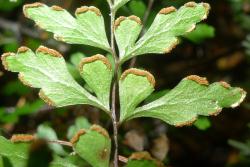Terrestrial (NZ) or rarely epiphytic (not NZ) ferns. Rhizomes short- to long-creeping, scaly. Fronds monomorphic or rarely dimorphic, not articulated to rhizome. Laminae 1–4-pinnate (NZ) or rarely undivided or more than 4-pinnate (not NZ), anadromous, herbaceous or coriaceous, glabrous (NZ) or rarely hairy (not NZ). Veins free (NZ), or rarely reticulate (not NZ). Sori oblong or extending laterally or almost continuous around the lamina margin, superficial, borne on abaxial surface, marginal or submarginal; paraphyses present; indusia present, attached at base and sometimes at the sides, opening towards the lamina margin; sporangial maturation mixed. Sporangia with vertical annulus, usually 32 spores per sporangium. Homosporous; spores monolete or trilete, lacking chlorophyll; perispores smooth or granulate.
A family of eight or nine genera and about 200 species (Lehtonen et al. 2010), three-quarters of them in the genus Lindsaea.
The lindsaeoid ferns were extensively studied by Kramer and included by him in the Dennstaedtiaceae (Kramer 1990). However, Smith et al. (2006) recognised the Dennstaedtiaceae and Lindsaeaceae as two separate families, the latter encompassing eight genera – Cystodium, Lindsaea, Lonchitis, Odontosoria, Ormoloma, Sphenomeris, Tapeinidium and Xyropteris. The lindsaeoid ferns were only sparingly sampled in early molecular studies, but a comprehensive analysis of the family by Lehtonen et al. (2010) examined 73% of the species and all but one of the genera. They found six well-supported clades, which they recognised as the genera Lindsaea, Nesolindsaea, Odontosoria, Osmolindsaea, Sphenomeris and Tapeinidium. However, Ormoloma was found to be embedded in Lindsaea, the status of Cystodium and Lonchitis as members of the family was ambiguous, and the monotypic Xyropteris was not sampled. Although clearly distinct genetically, the genera of Lindsaeaceae are rather poorly defined morphologically, with few characters that can be consistently used to distinguish them. The Lindsaeaceae are believed to be one of the early-diverging lineages amongst the polypod ferns (Lehtonen et al. 2010).
The Lindsaeaceae are a largely tropical family. They are represented in New Zealand by only three indigenous species of Lindsaea and one species of Odontosoria that is known as a casual escape from cultivation. The family is also poorly represented in Australia where there are just 15 species of Lindsaea (Kramer & McCarthy 1998).
| 1 | Laminae 1–3-pinnate-pinnatifid; stipes red- or purple-brown; sori oblong or often extending laterally around the lamina margin | Lindsaea |
| Laminae 3–4-pinnate; stipes pale brown; sori oblong, rarely extending laterally | Odontosoria |
The Lindsaeaceae comprise predominantly terrestrial ferns with short- to long-creeping rhizomes, mostly 1–3-pinnate, glabrous fronds, marginal or submarginal sori that tend to elongate around the lamina edge, and indusia that are attached at the base and open towards the lamina margin. The sporangia have a vertical annulus.
A pantropical family but with several species extending into temperate regions in South America, east Asia and Australasia (Lehtonen et al. 2010). The greatest diversity is found in the Old World tropics. Two non-endemic genera with four species in New Zealand; one endemic species.
| Category | Number |
|---|---|
| Indigenous (Endemic) | 1 |
| Indigenous (Non-endemic) | 2 |
| Exotic: Casual | 1 |
| Total | 4 |




